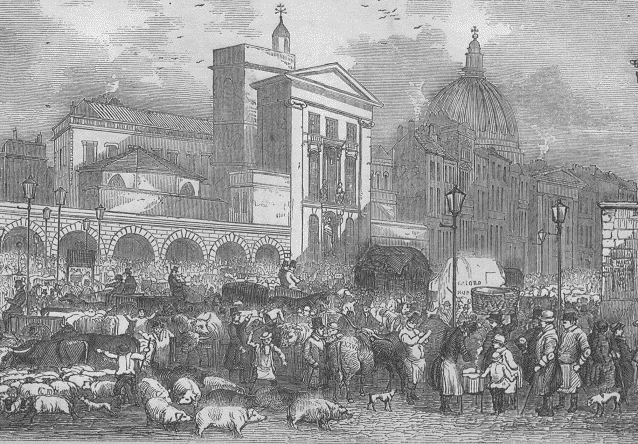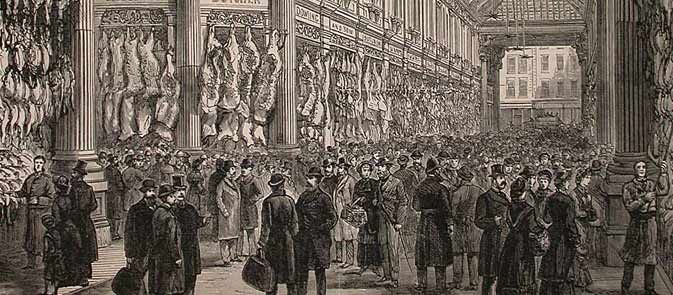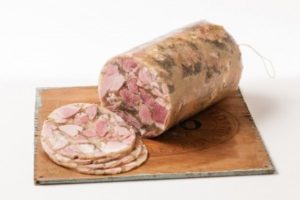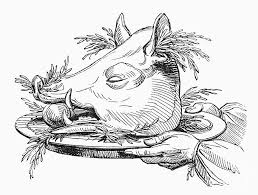
From The Book of Christmas: Descriptive Customs, Ceremonies, Traditions by Thomas Kibble Hervey (1845)
Everywhere, throughout the British Isles, Christmas-eve is marked by an increased activity about the good things of this life. “Now,” says Stevenson, an old writer, “capons and hens, besides turkeys, geese, ducks, with beef and mutton, must all die; for in twelve days, a multitude of people will not be fed a little . . .” The abundant displays of every kind of edible, in the London markets, on Christmas-eve, with a view to the twelve days’ festival, the blaze of lights amid which they are exhibited, and the evergreen decorations by which they are empowered —together with the crowds of idlers or of purchasers that wander through these well-stored magazines—present a picture of abundance, and a congress of faces, well worthy of a single visit from the stranger, to whom a London market, on the eve of Christmas, is, as yet, a novelty.

The approach of Christmas-eve, in the metropolis, is marked by the Smithfield show of over-fed cattle; by the enormous beasts and birds, for the fattening of which medals and cups and prizes have been awarded by committees of amateur graziers and feeders;—in honor of which monstrosities, dinners have been eaten, toasts drunk, and speeches made. These prodigious specimens of corpulency we behold, after being thus glorified, led like victims of antiquity, decked with ribands and other tokens of triumph— or perhaps, instead of led, we should, as the animals are scarcely able to waddle, have used the word goaded—to be immolated at the altar of gluttony, in celebration of Christmas! To admiring crowds, on the eve itself, are the results of oil-cake and turnip feeding displayed, in the various butchers’ shops of the metropolis and its vicinity; and the efficacy of walnut-cramming is illustrated in Leadenhall market,—where Norfolk turkeys and Dorking fowls appear, in numbers and magnitude unrivalled. The average weight given for each turkey, by the statement heretofore quoted by us, of the number and gravity of those birds sentup to London from Norfolk, during two days of a Christmas, some years ago—is nearly twelve pounds; but what is called a fine bird, in Leadenhall Market, weighs, when trussed, from eighteen to one or two-and-twenty pounds,—the average price of which may be stated at twenty shillings; and prize turkeys have been known to weigh more than a quarter of a hundred weight.

Brawn is another dish of this season; and is sold by the poulterers, fishmongers, and pastry-cooks. The supply for the consumption of London is chiefly derived from Canterbury, Oxfordshire, and Hampshire. “It is manufactured from the flesh of large boars, which are suffered to live in a half-wild state, and, when put up to fatten, are strapped and belted tight round the principal parts of the carcass, in order to make the flesh become dense and brawny. This article comes to market, in rolls about two feet long, and ten inches in diameter, packed in wicker baskets.”

Another feature of this evening, in the houses of the more wealthy, was the tall Christmas candles, with their wreaths of evergreens, which were lighted up, along with the Yule log, and placed on the upper table, or dais, of ancient days. Those of our readers who desire to light the Christmas candles, this year, may place them on the sideboard, or in any conspicuous situation.

Our account of Christmas would not be complete,—without giving some description of the forms which attended the introduction of the boar’s head at the feasts of our ancestors. The boar’s head soused, then, was carried into the great hall, with much state; preceded by the Master of the Revels, and followed by choristers and minstrels, singing and playing compositions in its honor. Dugdale relates that at the Inner Temple, for the first course of the Christmas dinner, was ” served in, a fair and large bore’s head, upon a silver platter, with minstrelsye.” At St. John’s, Oxford, in 1607, before the bearer of the boar’s head,—who was selected for his height and lustiness, and wore a green silk scarf, with an empty sword-scabbard dangling at his side,—went a runner, dressed in a horseman’s coat, having a boar’s spear in his hand,—a huntsman in green, carrying the naked and bloody sword belonging to the head-bearer’s scabbard,—and “two pages in tafatye sarcenet,” each with a “mess of mustard.”
